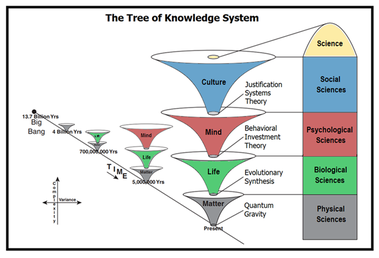This article has multiple issues. Please help improve it or discuss these issues on the talk page . (Learn how and when to remove these template messages)
|

The tree of knowledge (ToK) system is a new[ when? ] map of Big History that traces cosmic evolution across four different planes of existence, identified as Matter, Life, Mind and Culture that are mapped respectively by the physical, biological, psychological and social domains of science. The Tree of Knowledge (ToK) System was developed by Gregg Henriques, who is a professor and core faculty member in the Combined-Integrated Doctoral Program in Clinical and School Psychology at James Madison University. [1] The ToK System is part of a larger Unified Theory of Knowledge that Henriques describes as a consilient scientific humanistic philosophy for the 21st Century.
Contents
- Dimensions and planes of existence
- Matter/Object — Physical sciences
- Life/Organism — Biological sciences
- Mind/Animal — (Basic) psychological sciences
- Culture/Person — Human social sciences
- Theoretical joint points
- Quantum gravity
- The modern synthesis
- Behavioral investment theory
- Justification systems theory
- The "problem of psychology"
- Solution
- Consciousness and human behavior
- Toward the integration of human knowledge
- See also
- References
- Bibliography
- External links
The official Unified Theory of Knowledge website describes the ToK System as: [2]
[A] theory of scientific knowledge that defines the human knower in relation to the known. It achieves this novel accomplishment by solving the problem of psychology and giving rise to a truly consilient view of the scientific landscape. It accomplishes this via dividing the evolution of behavioral complexity into four different planes of existence...The ToK also characterizes modern empirical natural science as a kind of justification system that functions to map complexity and change.
The outline of the ToK System was first published in 2003 in Review of General Psychology . [3] Two special issues of the Journal of Clinical Psychology in December 2004 [4] and January 2005 [5] were devoted to the elaboration and evaluation of the model. In 2008, a special issue of Theory & Psychology [6] was devoted to the ToK System. In 2011, Henriques published A New Unified Theory of Psychology . That same year he also launched the blog Theory of Knowledge: A Unified Approach to Psychology and Philosophy on Psychology Today, which remains active. There is also a Theory Of Knowledge Society and discussion listserve that is devoted to discussing Henriques' work and other big picture viewpoints.
In some ways, the ToK System reflects a fairly common hierarchy of nature and of the sciences that has been represented in one way or another since the time of Auguste Comte, who in the 19th century used a hierarchical conception of nature to argue for the existence of sociology. It also has clear parallels with Aristotle's conception of the scales of nature and the first four levels of the Great Chain of Being.
Despite some overlap with a number of traditional schemes, the ToK System is properly thought of as a new theory of both ontic reality and our scientific knowledge of that reality. One of the most important and salient features of the Tree of Knowledge is how it represents reality as consisting of four different planes of existence. The theory is that, following Matter, Life, Mind and Culture each represent complex adaptive landscapes that are organized and mediated by novel emergent information processing and communication systems. Specifically, DNA/RNA store information that is processed by cells which then engage in intercellular communication to create the plane of existence called Life. Similarly, the brain and nervous system store and process information in animals which then engage in communication networks on the complex adaptive plane called Mind. Finally, linguistic storage and processing and communication between human beings generates the emergence of the Culture-Person plane of existence.
The separable planes of existence or dimension of complexity argument is one of the most crucial aspects of the system. Many have argued nature is hierarchically leveled; for example, a list of such levels might be subatomic particles, atoms, molecules, cells, organ structures, multi-celled organisms, consciousness, and society is common. The ToK System embraces a view of nature as levels, but adds the notion that there are also separable dimensions of complexity. The difference becomes particularly clear in the extension of the ToK System into the Periodic Table of Behavior. The Periodic Table of Behavior (PTB) shows that natural science can be arranged in terms of the four fundamental dimensions (i.e., matter, life, mind, and culture) and three fundamental levels of analysis (i.e., part, whole, group). The PTB also demonstrates that behavior is a central concept in science. Epistemologically, natural scientists view the world via a third person behavioral lens. Ontologically, science is about mapping different kinds of behaviors that take place in nature at various levels and dimensions of analysis.
The second central insight of the ToK System is that it shows how natural science is a particular kind of justification system that emerges out of Culture based on novel methods and specific epistemological commitments and assumptions (i.e., an exterior view point, quantification and experimentation). This epistemology and methodology functions to justify scientific ontology, which in turn maps the ontic reality. Specifically, the domains of the physical, biological, (basic) psychological and social sciences map the ontic dimensions of matter, life, mind and culture. The Periodic Table of Behavior further shows how science is a justification system that is arranged to map behavioral frequencies at different dimensions of complexity and levels of analysis.




